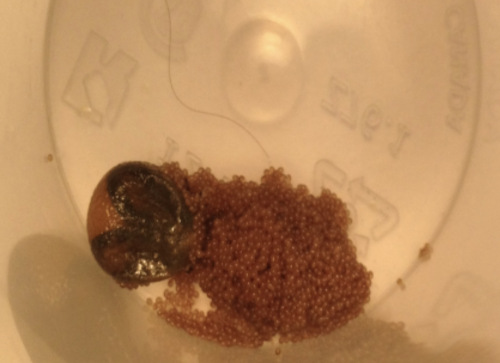As summer approaches and heat and humidity set in, warmer temperatures can increase tick activity within the Nova Scotia area.
Amal El Nabbout, a Ph.D. candidate at Dalhousie University in the Department of Biology, has published many scholarly studies on the topic of ticks and is currently working on her thesis, Biotic and Abiotic Factors Influencing Survival of Exodus Scapular ticks in Nova Scotia.
She discusses preventive measures, the diseases they carry, their lifespan, how they feed, their different types and actions to take after being bitten.
“Ticks belong to the arthropod, and they belong to the mite super order. They're parasitic, and they're considered Ectoparasites. Ectoparasites mean they are external to the body. They're not internal, even though they burrow their head in the skin," El Nabbout said. "They vary from three to five centimetres in length, depending on the sex, the species, how full they are, where they are in their feeding stage, and so on.”
There are at least 14 different species of ticks that have been found in Nova Scotia, but only a few bite humans. El Nabbout said Nova Scotia has a suitable climate for tick populations.
"Nova Scotia has a perfect climate for them. They love humid places, and we have a lot of humidity here. They thrive in areas that have shrubs, wooded areas where there are trees and shades, most likely wherever you find high humidity; it's a very suitable environment for them."
Other prime spots for ticks are low-lying ground covers and low-hanging shrubs in gardens: El Nabbout said one of the ways to avoid ticks on your garden or property is by keeping the grass short. Adding barriers such as stones or fences that divide your lawn from nearby forests or woods is also another effective preventive measure.
"When you go walking into forests and areas with ticks, Well first advice is don't go there. Second is to probably wear light coloured clothing so that you can see them on you right away on you. Also, tuck your pants inside your socks so they don't find a way to get to you to your skin. And do your daily tip check for yourself, kids and pets," El Nabbout said.
Since cases were first recorded in 2002, there have been 120 cases of Lyme disease reported in Nova Scotia, of which 101 (84 per cent) were likely acquired within the province. A definite tick bite was reported in 25.8 per cent of cases.
Ticks carry a lot of diseases. The most common one in dogs would be Rocky Mountain spotted fever. As for deer ticks, they carry Lyme disease.
Lyme disease is a bacterial infection that can cause early symptoms such as a rash, fever, headache and fatigue. If not treated early, the infection can spread to the joints, heart and nervous system. If not treated, Lyme disease can be fatal.
How do ticks acquire these diseases in the first place? El Nabbout explains how the diseases are aquired during a tick's lifecycle.
"Their lifecycle has three different stages. It goes from egg to larvae to nymph to adult. When they are larvae, they feed on birds and small mammals like rats and mice, and they get the bacteria that causes Lyme disease from there."
The bacteria does not go through the egg, the larvae acquire the bacteria from feeding as it grows with it from stage to stage, from larvae to nymph to adult.
"And every time they feed, they can actually suck the blood, filter it, and put it back into the body. And this is how the bacteria get into your body," El Nabbout said.
The colour of ticks changes depending on whether it has fed yet, or not.
"When a deer tick is fed, it has this dark changing colour, red becomes a bit engorged and it changes to a darker brown or grey. That means it's been attached to its host for at least 36 hours."
Ticks do not get under the skin, they burrow their head in the skin after attaching themselves to a nearby host.
"They don't jump, they don't fly, they have to latch on you. Once they get to your skin, they start crawling up usually, to find a place that is moist and easy to pierce through. So the skin has to be very thin, in places like the underarms, groin areas, and inner elbows."
After sitting on the skin, they pierce it. However, because they inject some kind of anesthetic, not all people can feel them. The length of feeding time depends on their life stage.
"If it's larvae, which is the first stage, it usually feeds for three days, and then the second stage would last four to five days. Adult ticks stay on you for about seven to ten days feeding. Scary," El Nabbout said.
Although rare, in some cases, ticks might cause tick paralysis if they are attached to the body for some time.
"They release some kind of neurotoxin that might affect people's nervous system."
Usually, after feeding, ticks become engorged and fall off the body. After falling off, they lay their eggs somewhere in a leaf litter, then die.
The long-lasting side effects of tick bites can include fatigue, restless sleep, aching joints or muscles, swelling, decreased short-term memory or ability to concentrate and speech problems.
"Their lifespan is two to three years, and each female tick can lay up to 2,000 eggs and that is why their population is increasing."

A female dog tick laying up to 2,000 eggs at Dalhousie University biology labs. Photo contributed.
El Nabbout is working on a project to discover how to decrease the tick population.
"We're working on a specific type of formulation that we can apply probably during the fall on people's lawns. We're hoping that it will reduce the tick numbers in the coming spring, because ticks are most active in spring and fall."
Although they are most active during the spring and fall times, they found a way to adapt during winters by burrowing under leaf litter to avoid colder temperatures.
"They go through a stage called diapause or quiescence, and whenever they reach a certain temperature, they wake up again."
For effective sprays, El Nabbout recommends using any spray with DEET in it, which is an active ingredient in many repellent products which are also used to fight off mosquitoes.
"Something people should also know about is the bull's eye rash. Usually when a tick bites a person or a human, in about 15-20% of the cases, it causes a bull's eye rash. Most people probably do not notice they got bitten by a tick unless they see something like this. But that doesn't mean that if you don't have it, you don't get bit. Because it only shows him 20 per cent of the people that get it."
If that happens, a trip to the hospital is required to start taking antibiotics.
El Nabbout did her master's study at Mount Allison University, in Sackville, New Brunswick, and, originally, focused on dog ticks since they are common in Nova Scotia.
"Usually, dog ticks are much bigger than deer ticks and the colour is different like there's a pattern on their body that is not found on deer ticks."
She said an opportunity arose for her to pursue a Ph.D. in her current field.
Her current research study, Biotic and Abiotic Factors Influencing Survival of Exodus Scapular ticks in Nova Scotia, focuses mostly on overwintering ticks.
"I've been putting some experiments at the Harrison Lewis Center at Port Joli. I collect ticks, put them in specific microcosm tubes in the fall, and record the temperature and humidity in that specific site for a whole three months."
Then she collects them to see if they are dead or alive, and what the percentage is of ticks that survive the winter.
"After that, we take them to the laboratory and test to see whether they have the bacteria that causes Lyme disease. Is there a correlation between the bacteria presence and the survival of the ticks? Does it make them more resistant to cold winters? And if infected do they survive better? Usually, they do, this is what I'm finding right now."
Research from Switzerland done on similar ticks living in their area found that if ticks are infected, it makes them survive harsher environments and survive better overall. That research inspired El-Nabbout to start her project.
"This is what we're looking for, if ticks aren't infected, is there a correlation between this infection and their survivability during the winter? Does temperature have anything to do with this? So basically, we're working on overwintering temperature and things we have a paper that is in the process of being published."
Having tested several types of leaf litter, this paper discusses a specific type of leaf litter that can help keep ticks away from people's homes.
"So we started testing the leaf litter in areas known Nova Scotia, because usually leaves fall and then the ticks burrow underneath the leaf litter so they can overwinter and then come out in the spring. During the three years, we've been noticing that a certain leaf litter makes them not survive, as well as the others. And this is how we came across finding that natural product that will probably help people keep ticks away from their homes and things like that."
She said the specific type of tree is none other than a popular Christmas tree type, the Balsam Fir.
"We are in the process of releasing that publication."
Listen to the full interview below:


